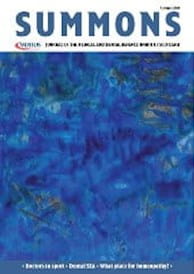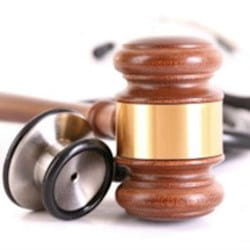THIS article attempts to highlight some of the problems, both clinical and medico-legal, that may arise when managing head injuries. It is not possible in a review of this length to provide comprehensive guidance on all aspects of this complex topic. Interested readers are advised to consult standard texts and, in particular, the NICE guidelines for head injury management.
Scale of the problem
Head injury is the commonest cause of death amongst young adults in developed countries. Each year in the UK, approximately one million people will receive treatment for mild to severe head injuries in accident and emergency departments. Of these, 100,000 will be admitted for observation or specific treatment. In 5 per cent of those admitted to hospital, a neurosurgical opinion will be sought. Of those referrals, 1,500 individuals will have sustained permanent brain damage or remain in a persistent vegetative state.
Head injury accounts for half of all deaths among adolescent males aged between 15 and 19 years, and if death occurs after a road traffic accident there is a 75 per cent chance it will be directly attributable to the head injury itself.
It is important to appreciate that patients who have sustained head injuries are often the subject of medico-legal action in one form or another. It is therefore vital that doctors who treat head-injured patients have a thorough understanding of the principles of management and the medicolegal consequences that might flow from the injury.
The NICE guidelines are essential reading for all those who may be called upon to treat head-injured patients. Here you can find guidance on:
• Pre-hospital management
• Initial assessment in the emergency department
• Criteria for imaging and its urgency for adults and children
• Investigation of cervical spine injuries
• Admission criteria
• When to involve a neurosurgeon
• Organisation of transfer of patients between referring hospital and neuroscience unit
• Advice about long-term problems and support services.
If you read nothing else, study the Quick Reference Guide on head injury which can be downloaded from the NICE website1.
Surgical pathology
It is important for all clinicians who manage head-injured patients to have a basic understanding of the surgical pathology.
Head injury is traditionally divided into primary and secondary brain injury. Primary brain injury occurs at the time of impact. It is divided into contusions and lacerations of the brain on the one hand and diffuse axonal or shearing injury on the other. Apart from preventative measures, such as wearing crash helmets, adhering to speed limits and so forth, there is nothing that can be done about such primary damage.
Secondary brain damage such as swelling, oedema, haematoma formation, epilepsy and infection are initiated by the primary damage and it is the goal of the clinician to avoid or minimise such damage, although this may not always prove possible.
Assessment of a head-injured patient requires a careful history and examination. Details of the mechanism of the injury are important and should be obtained from appropriate witnesses as well as the patient. For example, a blow to the head with a heavy spanner is more likely to result in a compound depressed fracture than an assault with fists.
The initial neurological examination is of vital importance not only because it enables the severity of the injury to be gauged but also because it provides a baseline of neurological function from which any improvement or deterioration can be measured.
The assessment should include the Glasgow Coma Scale (GCS), recording of vital signs and recording of the presence or absence of focal neurological deficit. It is vital that you have a clear and thorough understanding of the GCS and know how to derive the overall score from each of the three parameters that constitute it. Despite being in existence since 1974, our unit continues to receive referrals that quote a GCS of 1 or 2!
Frequently asked questions
Head-injured patients and their relatives will invariably want to know the time frame during which recovery can take place. It is generally held that spontaneous improvement can take place for up to two years after a traumatic brain injury. Problems that persist thereafter can be regarded as being fixed, i.e. they should neither improve nor deteriorate.
Another common question which is important to address is the likelihood of developing post-traumatic epilepsy. Traditionally this is divided into early post-traumatic epilepsy, which arises up to seven days after the injury, and late post-traumatic epilepsy, which arises at any time thereafter.
Risk factors for the development of late post-traumatic epilepsy include: early posttraumatic fits, structural brain damage, penetrating injuries and a period of posttraumatic amnesia greater than 24 hours.
The most widely cited paper on the risk and likelihood of developing posttraumatic epilepsy is by Annegers2 and his group and this makes essential reading for anyone who is engaged in medico-legal reporting on head-injured patients.
Medico-legal issues
Head injuries feature commonly among clinical negligence claims and some can result in high-value damage payouts or settlement costs. Among the most frequent reasons for negligence claims are:
• delay in diagnosis
• failure to appreciate the severity of the injury
• delay in transfer to a neurosurgical centre
• missed spinal injury
• incorrect attribution of loss of consciousness to alcohol or drugs.
Many categories of clinician are called upon to assess patients who have sustained head injuries. As in all areas of practice, accurate note keeping is essential and can provide a valuable safeguard and defence to subsequent complaints and litigation. Ensure that all entries in the clinical records are timed and dated.
A thorough understanding of the NICE guideline for managing head-injured patients and the maintenance of a high index of suspicion, especially in intoxicated patients with head injuries, will mitigate against inappropriate management and the tragedy of a death occurring when a surgically remediable condition is missed.
Medico-legal issues to consider in head injury
• Treatment of victims of crime
• Criminal Injuries Compensation Authority (CICA) reports
• Negligence surrounding management
• Personal injury compensation claims
• DVLA forms
Practice points
• All head injuries should be regarded as serious or potentially life-threatening.
• Head injuries are associated with a cervical spine injury until proven otherwise.
• The purpose of observation is to set a baseline from which improvement or deterioration can be assessed.
• Minor head injury may be a source of considerable morbidity.
• A head injury does not just affect the patient; the family and society may also be seriously affected.
Professor Paul Marks is a consultant neurosurgeon at Leeds General Infirmary and HM Deputy Coroner, West Yorkshire (Western District). He is also a visiting professor and associate at Leeds Metropolitan University Law School
References
2 Annegers JF et al. A population-based study of seizures after traumatic brain injuries. NEJM (1998):338;1:20-24
----------------------------------------------------------------------------
This page was correct at the time of publication. Any guidance is intended as general guidance for members only. If you are a member and need specific advice relating to your own circumstances, please contact one of our advisers.
Read more from this issue of Insight

Save this article
Save this article to a list of favourite articles which members can access in their account.
Save to library

